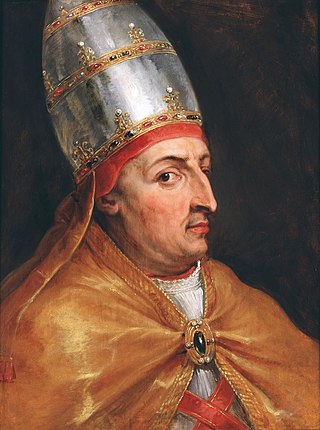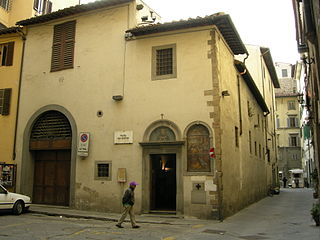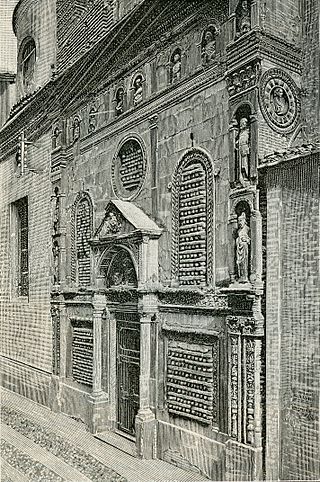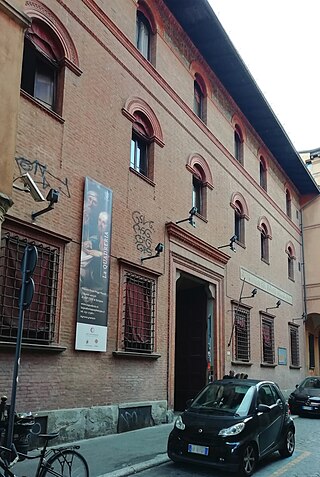
Pope Nicholas V, born Tommaso Parentucelli, was head of the Catholic Church and ruler of the Papal States from 6 March 1447 until his death, in March 1455. Pope Eugene IV made him a cardinal in 1446 after successful trips to Italy and Germany, and when Eugene died the next year, Parentucelli was elected in his place. He took his name Nicholas in memory of his obligations to Niccolò Albergati.

Gerolamo Emiliani, CRS was an Italian humanitarian, founder of the Somaschi Fathers, and is considered a saint by the Catholic Church.

A mount of piety is an institutional pawnbroker run as a charity in Europe from Renaissance times until today. Similar institutions were established in the colonies of Catholic countries; the Mexican Nacional Monte de Piedad is still in operation.

Ferdinando Gasparo Bertoni was an Italian composer and organist.

The Ospedale degli Innocenti 'Hospital of the Innocents', also known in old Tuscan dialect as the Spedale degli Innocenti, is a historic building in Florence, Italy. It was designed by Filippo Brunelleschi, who received the commission in 1419 from the Arte della Seta. It was originally a children's orphanage. It is regarded as a notable example of early Italian Renaissance architecture. The hospital, which features a nine bay loggia facing the Piazza SS. Annunziata, was built and managed by the "Arte della Seta" or Silk Guild of Florence. That guild was one of the wealthiest in the city and, like most guilds, took upon itself philanthropic duties.

San Martino del Vescovo, also known as the Oratorio dei Buonomini di San Martino, is a Roman Catholic parish church, located in the small piazza of the same name in Florence, Italy.
The Scuole Grandi were confraternity or sodality institutions in Venice, Italy. They were founded as early as the 13th century as charitable and religious organizations for the laity. These institutions had a key role in the history and development of music. The first groups of bowed instrument players named Violoni were born there in the early 16th century.

Confraternities of penitents are Christian religious congregations, with statutes prescribing various penitential works; they are especially popular in the Catholic Church. Members of the confraternities of penitents practice mortification of the flesh through fasting, the use of the discipline, the wearing of a hair shirt, among other instruments of penance, etc.

Bologna is the capital and largest city of the Emilia-Romagna region in Northern Italy. It is the seventh most populous city in Italy, with about 400,000 inhabitants and 150 different nationalities. Its metropolitan area is home to more than 1,000,000 people. It is known as the Fat City for its rich cuisine, and the Red City for its red tiled rooftops and, more recently, its leftist politics. It is also called the Learned City because it is home to the oldest university in the world.
The College of the Neophytes, in Italian Collegio dei Neofiti was a Roman Catholic college in Rome founded in 1577 by Gregory XIII for education of young men, in an institution for converts from Judaism and Islam that itself been started in 1543 by Pope Paul III. Neophyte in this context generally means converts from Judaism, and neofito was often appended to Italian surnames to indicate a convert. From 1634 the College was adjacent to the church of Santa Maria ai Monti.

Santa Lucia del Gonfalone is a church in the diocese of Rome, Italy. It is located on Via dei Banchi Vecchi just one block south of Corso Vittorio Emanuele. The former site of the Archconfraternity of the Gonfalone, the Claretian Missionaries have their provincial headquarters here. The church was made a cardinalate deaconry by Pope John Paul II on 21 October 2003.
The Cemetery of the 366 Fossae or Cimitero di Santa Maria del Popolo or Cimitero dei Tredici was built in 1762 a short distance from the then-dilapidated Villa Poggio Reale, and is located on a terrace of a hill overlooking the Poggioreale neighborhood of Naples, Italy. It is near the monumental Cemetery of Poggioreale, which was built on top of the ruined villa. The architect was the Florentine Ferdinando Fuga.

The Ospizio di San Michele a Ripa Grande or Ospizio Apostolico di San Michele in Rome is a complex represented by a series of buildings in the south end of the Rione Trastevere, facing the Tiber River and extending from the bank of Ponte Sublicio for nearly 500 meters. It stands across the river from the Rione Ripa and the area known as the Porto di Ripetta, once in the Aventine neighborhood of Rome. The Porto di Ripa Grande was the river port that served those coming up from the Mediterranean port of Ostia. This area was once a main port of Rome. While large seafaring ships could not forge easily up the Tiber river to Rome; smaller boats frequently brought supplies from the coast to the city and offloaded at the Porta.

The Madonna di Galliera is a church with a Renaissance facade and Baroque interiors, located on Via Manzoni, in central Bologna, Italy. It stands in front of the Palazzo Ghisilardi Fava. The present name over the portal is the Chiesa di Filippini Madonna di Galliera e Filippo Neri.

San Nicolò di Bari is a deconsecrated Roman Catholic church, built in a Romanesque, early Renaissance-style located in the town of Alcamo, in the province of Trapani on the island of Sicily, Italy.

San Giacomo della Spada is a Catholic church in Alcamo, in the province of Trapani, adjoining it there was the Hospice of Pilgrims.

The Ospedale degli Incurabili is a large sixteenth-century hospital building on the Fondamenta delle Zattere, in the sestiere of Dorsoduro, in Venice in north-eastern Italy. Today it is occupied by the Accademia di Belle Arti di Venezia. It was built in the second half of the sixteenth century; the church – which no longer exists – may have been designed by Jacopo Sansovino.

The Palazzo Rossi Poggi Marsili is a palazzo in Via Marsala #7, Bologna, Italy. It was once home of the Opera Pia dei Poveri Vergognosi or Charity home for the Shameful Poor, but now houses a Quadreria or painting gallery gathered by "ASP Città di Bologna", which derived from the joining of various charities.

The Piagnoni were a group of Christians who followed the teachings of Girolamo Savonarola. The later Piagnoni remained in the Catholic Church and kept a mixture with the teachings of Catholic dogma and the teachings of Girolamo Savonarola. The name Piagnoni was given because they wept for their sins and the sins of the world.

Palazzo Mandelli is a Baroque architecture-style palace located at the corner of Vie Bernardino Mandelli and San Marco in central Piacenza, region of Emilia-Romagna in Italy. The main portal rises in front of the church of San Dalmazio. The palace is presently home to the Banca d'Italia in Piacenza.

















